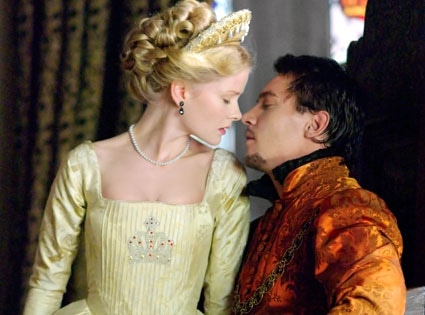 Jonathan Hession/Showtime
Jonathan Hession/ShowtimeThe Tudors is over again. (Didn't it just start up?) Sniff.
After last night's heart-wrenching (not to mention neck-slicing) season-two finale, I had more than a few burning questions for executive producer and writer Michael Hirst, who kindly picked up the phone at his home in Oxford, England, to oblige.
Click in to get the goods...
It Ain't Easy Being Queen: I don't know you about you, but I was bowled over by Natalie Dormer's Anne Boleyn in her final days. (And I bawled when she finally took her place on the executioner's platform.) Anne seemed quite aware of her impending fate (although no one ever expects the Spanish Inquisition English Reformation), and as her last-ditch efforts to survive failed, one by one, she handled the crisis with the utmost grace and dignity.
Hirst says that was entirely intentional. "Natalie was upset and stunned during the first series when a few—particularly American—journalists said she's just a bit of fluff. [They thought she was] just manipulative, cold and heartless, and said, 'We want to see the end of this bitch.' Natalie said that her reading of Anne was that she was a very intelligent woman who had a very profound effect on the future of England—not only giving birth to Elizabeth, but in person. And I said, 'I totally agree.' Natalie said, 'I just want to prove them wrong—can you throw everything at me?' So in the second series I very, very consciously threw everything at her, and she responded incredibly. That last episode, I think, if you had any lingering feelings against her, they're completely washed away by the manner of her death, and you feel extraordinary sympathy with her, and her courage is fantastic. It was a great performance."
Everything Old Is New Again: The Anne of The Tudors is very consciously modeled after another controversial royal of our own era. Says Hirst, "I think that [Anne]'s a conduit; she allows women to understand now that [queen] is a bad job. Katherine of Aragon (Maria Doyle Kennedy)—that was a wonderful performance, too—was born to rule, so that's a different deal. Anne had to learn on the job...There are parallels, too, between Anne Boleyn and Diana, Princess of Wales. There are deliberate connections, in fact. Diana had said, 'There can't be three people in a marriage,' and Anne Boleyn uses the same words."
Neeext! Now that poor Anne is out of the way, it's time to introduce Jane Seymour (Anita Briem), who was Henry VIII's third wife and the mother of his only sons to survive infancy. In history, she doesn't last too long, but on the show she will be around at least the midpoint of season three. And when she goes—dying from puerperal fever (a systemic infection subsequent to childbirth)—shortly after the birth of Edward VI, we ladies will make the proper genuflections to Alexander Fleming, he who discovered antibiotics.
The Crazy Keeps Comin': Henry's going to get worse before he gets better. Well, actually, he won't get any better. Says Hirst, "He did believe in the divine right of kings, and he did have absolute power, and like everyone else who gained absolute power, it turned him mad. By the end of his reign, he's a psychopath—nobody is safe in his court. It was much better to be dead than to be around Henry...And the tragedy was he set off so idealistically and optimistically. He was a great guy when he was young, and he let it all go, and it was a tragedy for the country." Raise your hand if you're feeling pretty good right now about being a lowly peasant.
Thinking Dynastically: Hirst thinks the story of Henry proper could be told in five seasons, but he's willing to plumb all branches of the family tree for stories. Says Hirst, "What I would like to do is go back to Henry VII, Henry VIII's father, and show how the dynasty was set up, because that's interesting, and then I'd kind of like to jump forward to his son Edward VI, with Seymour, as Lord Protector—and then Queen Mary, who tried to reintroduce Catholicism. Mary married the king of Spain, and then thought she was pregnant, but it was a tumor. And she nearly killed her own sister Elizabeth. That's an amazing period."